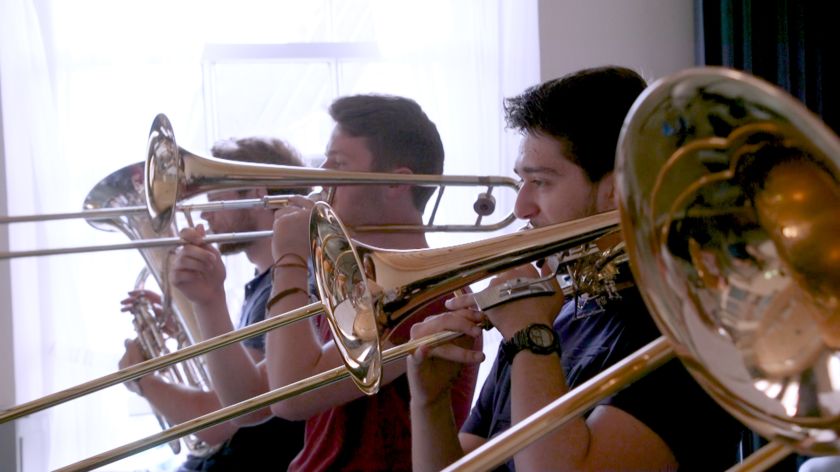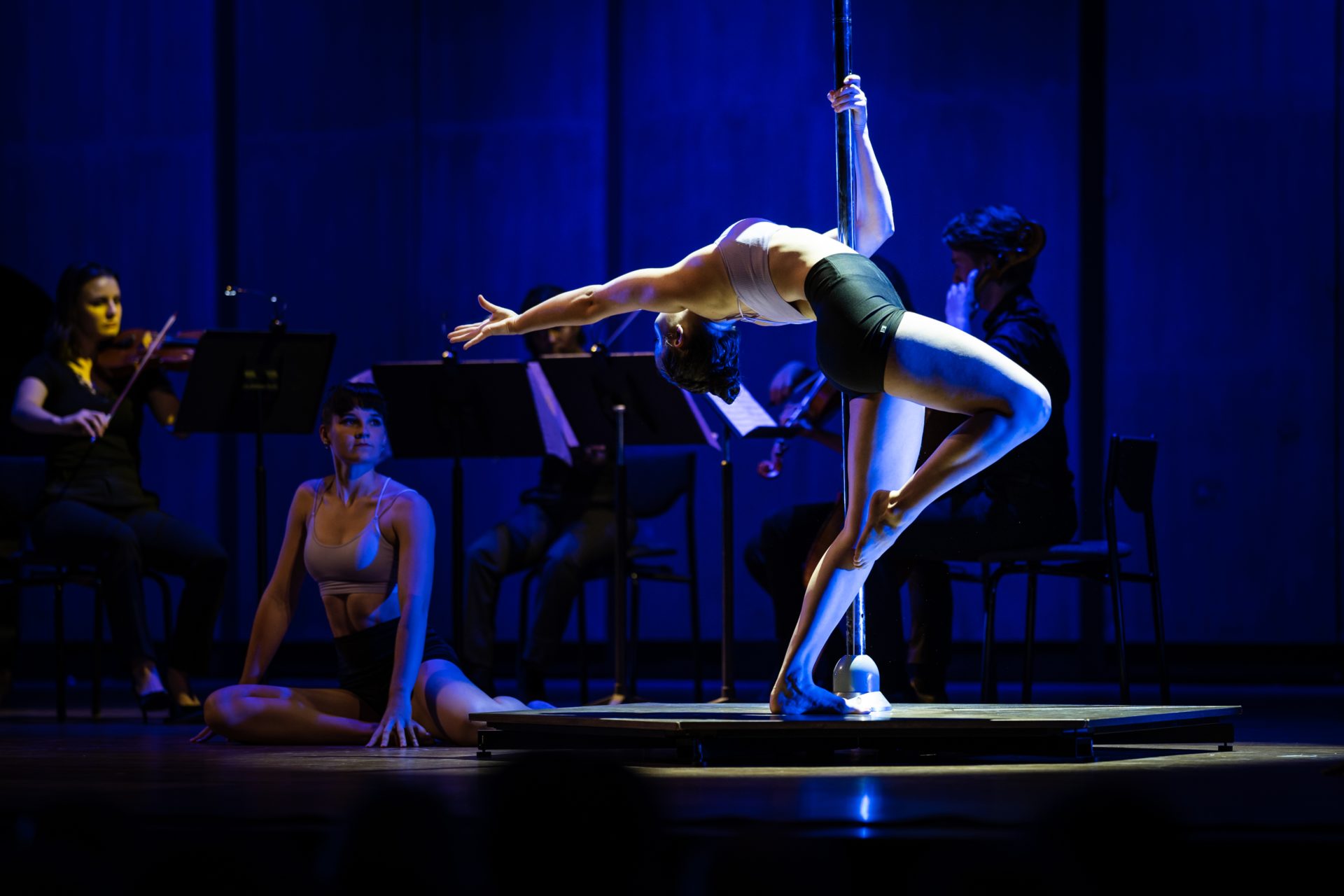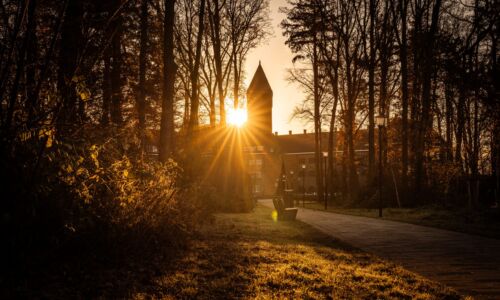-
 Studenten Bigband Nijmegen
Studenten Bigband Nijmegen
The future plans for Radboud University leave too little room for culture, student Mika Kraft wrote last spring. That’s not true, say those responsible for culture at Radboud University. But does this mean we’ll have a new cultural centre after all?
What will the campus of the future look like? Radboud University broadly outlined its answer to this question in April of this year. The plans include demolishing the Lecture Hall Complex and the Linnaeus building, and building a new Humanities building on the location of the Spinoza building. The Erasmus building will be redesigned, among other things to include student accommodation.
According to Mika Kraft, student of Cultural Anthropology and Development Sociology, these plans leave too little room for culture. Why is there no mention of a new cultural centre, he asked in an op-ed on voxweb.nl, while sports is given ‘impressive facilities? Kraft’s conclusion: ‘Sports is the main focus; culture is just a sideshow.’
Not forgotten
Now, with the new academic year starting, those responsible for culture on campus are responding to Kraft’s claim. Which is erroneous, in their opinion.
But who are these people responsible for culture? First of all, there is Cultural Science expert Martijn Stevens, who switched two years ago from the Faculty of Arts to the Academic Affairs department, where he now works as culture coordinator.
Then there is development manager Ferry Soetekouw, who, as a representative of the Campus & Facilities department, works on the ‘bricks and mortar’, i.e., the actual creation of facilities such as rehearsal areas.
Thirdly, we have Joris Hermans, head of Sports, whose job also includes culture. The Sports Centre, which Hermans has led for the past 18 months, offers not only spinning and football lessons, but also cultural activities, such as photography, singing, and theatre.
Why do you think Kraft is wrong in saying that culture has been forgotten?
Hermans: ‘Our 2019 vision on culture and sports, which we are now implementing, states clearly that sports and culture both contribute to the University’s core activities: education, research, and knowledge transfer. The two themes are not dealt with differently.’
Soetekouw: ‘If Kraft was to read the campus plan, he’d see that funds have been reserved for expanding cultural activities, not sports activities. And we’re talking about millions of euros.’
‘We’re not a sports or cultural organisation, but a university’
Stevens: ‘Kraft talks about culture as a hobby. I think we need to take culture out of the leisure corner. My vision is that we deploy culture for personal development and to promote creativity in teaching and research. We can do this by integrating creative work forms in regular education. My next question is: Does this mean we have to build a new cultural centre, or talk to the faculties?’
Hermans: ‘The way I see it, the University no longer wants to see sports and culture as separate functions. We’re not a sports or cultural organisation, but a university. A cultural centre creates the impression that anything related to culture must take place there. But that’s precisely what we don’t want – we want to integrate it further into everything we do.’
Stevens: ‘Incidentally, this is already happening for culture, for example in partnerships with LUX, InScience, or the Wintertuin.’
Aren’t there also advantages to bringing cultural facilities together under one roof?
Stevens: ‘A cultural centre will only attract people who are intrinsically motivated to do something with culture. And that while there are many people who have a latent need for it, but who experience a centre as too high a threshold. These people will stay away. This is why I think we need to work with the faculties. Bundling certain facilities might make culture more appealing, but we should definitely not stop at that.’

Hermans: ‘The same is true of sports, which is only one form of physical movement. What I want is to also promote vitality among students and employees outside the gym, for example by redesigning our office spaces. If I had to choose again between building a sports centre and integrating sports more within the campus, I would opt for the latter. Or at least, I would give it serious consideration.’
At the same time, we clearly have a capacity problem. Indoor athletes have been begging for years for an extra sports hall, and cultural associations are only temporarily allowed to make use of the Spinoza building. Shouldn’t we simply create more exercise and rehearsal areas?
Soetekouw: ‘That is a question for the Culture and Sports work group. Together, we look at what facilities are needed. It’s not yet clear to me that we need more rooms. We try to use the space we have as multifunctionally as possible, and we don’t want to build facilities that will be left unused most of the time. This is why we’re also considering the facilities offered by our neighbours, like the University of Applied Sciences or the ROC. Right now, we’re exploring the option of using the Berchmanianum chapel (currently used in the daytime for graduations and other events, Eds.) in the evenings as a rehearsal space for big band and orchestra students.’
‘The current cultural facilities are under par. Mika is right about that.’
Hermans: ‘This discussion always used to end with the conclusion that we needed a third sports hall. New buildings were the standard go-to answer. But aren’t there other, more sustainable, solutions?’
Stevens: ‘The current cultural facilities are under par. Mika is right about that. This is something we need to work on, and we’re taking it into consideration, for example in our plans for the new Faculty of Arts and Faculty of Philosophy, Theology and Religious Studies buildings.’
If your current vision on culture and sports is implemented, how will this affect the classical lecture hall?
Hermans laughs: ‘Based on my vision on vitality, I’d say: let’s take out all the chairs! There are some study programmes in Scandinavia that have actually done it. We’re also designing our office spaces differently these days, so why can’t we do the same in education?’
Stevens: ‘We’ll use creative work forms more often in our teaching, for example by asking students to do a photography assignment or a podcast. This requires certain facilities. It might be better to teach such classes in a theatre than in a lecture hall. This is an issue that goes beyond culture or sports; it touches on every aspect of education.’
Soetekouw: ‘I don’t know much about teaching, but I don’t think we need to rebuild the entire campus to create more opportunities. If a lecturer wants their students to do some sculpting, we just have to make sure that the room in question has no carpet, otherwise we’ll get into trouble with the cleaners. With small interventions, you can design a space to be more flexible and multifunctional.’
Stevens: ‘That’s true. There’s no need to become fixated on new technologies. Sometimes, it might be enough for a lecturer to bring a box of crayons to class. Having said that, it’s also true that right now, we don’t have enough spaces on campus that invite innovative teaching forms. But what should these spaces look like? That is something we need to explore with students and lecturers.’
Translated by Radboud in’to Languages



